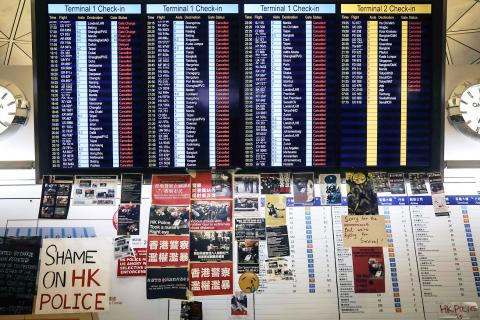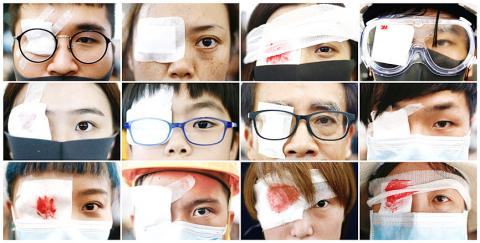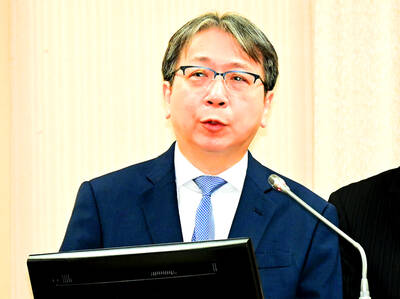One of the world’s busiest airports yesterday canceled all flights after thousands of pro-democracy demonstrators crowded into the main terminal of Hong Kong International Airport, while the central government in Beijing issued an ominous characterization of the protest movement as something approaching “terrorism.”
The extreme action by the largely leaderless movement seemed calculated to prompt a stern response from Beijing, and Chinese President Xi Jinping’s (習近平) administration responded within hours.
The Chinese State Council’s Hong Kong and Macau Affairs Office issued a statement saying the situation in Hong Kong was “beginning to show the sprouts of terrorism” and constituted an “existential threat” to the population.

Photo: AFP
“One must take resolute action toward this violent criminality, showing no leniency or mercy,” said the statement, attributed to spokesman Yang Guang (楊光). “Hong Kong has reached an inflection point where all those who are concerned about Hong Kong’s future must say ‘no’ to law breakers and ‘no’ to those engaged in violence.”
No new violence was reported by yesterday evening, although the territory remained on edge after more than two months of near-daily and increasingly bloody confrontations between protesters and police.
Beijing tends toward a broad definition of terrorism, including in it nonviolent protests of government policies on the environment or in minority regions such as Xinjiang and Tibet.

Photo: Reuters
Such a designation adds to the regime’s descriptions of protesters as clowns, criminals and traitors intent on overthrowing Chinese rule in Hong Kong.
A crowd of protesters that authorities said numbered more than 5,000 descended on the airport yesterday carrying placards and chanting slogans about police violence.
Hong Kong International Airport said in a statement the demonstration “seriously disrupted” airport operations.

Photo: AFP
Only flights that had already started boarding or those cleared for landing were allowed to use runways at the airport.
“All other flights have been canceled for the rest of today,” the airport statement said.
It later said flights would resume at 6am this morning.
Joydeep Chakravarti, a software engineer whose connecting flight to San Francisco was canceled during a layover in Hong Kong, expressed frustration that he was told to leave the airport when he wanted to stay inside the terminal.
“I don’t know what’s out there, so I don’t want to leave. I didn’t make any plans for Hong Kong,” said Chakravarti, who had a carry-on bag with laptop, charger and an extra shirt while the rest of his luggage already was checked in on his Singapore Airlines flight.
A massive traffic jam soon formed on the highway leading back to Hong Kong’s city center, but hundreds of protesters remained in the arrivals hall well into the night with no sign of leaving.
Some protesters were seen walking toward the airport amid the stifling heat.
At the airport, a flight attendant protesting on his day off, who gave only his surname, Lau, to avoid repercussions from his employer, said heavy-handed police tactics had alienated some people.
“The police have told a lot of lies to Hong Kong people. We cannot believe them anymore. We have to come here to protest,” Lau said.
Another protester, who identified herself only as Bea, said she took the day off from work to express her outrage because “I feel that I have to do something ... It’s just too sad to see what has happened. The police action has gone totally nonsensical.”
Later yesterday, two Chinese state media outlets ran videos showing armored personnel and troop carriers purportedly driving to Shenzhen, which borders Hong Kong.
The Global Times said the Chinese People’s Armed Police were assembling “in advance of apparent large-scale exercises.”
In an interview in Berlin, Chinese dissident artist Ai Weiwei (艾未未) said China’s leadership can now only resort to force, since it has failed in its quest to win hearts and minds in Hong Kong.
“Hong Kong people will not be the loser, because they’re on the right side of history,” he said.
Additional reporting by AFP

The US government has signed defense cooperation agreements with Japan and the Philippines to boost the deterrence capabilities of countries in the first island chain, a report by the National Security Bureau (NSB) showed. The main countries on the first island chain include the two nations and Taiwan. The bureau is to present the report at a meeting of the legislature’s Foreign Affairs and National Defense Committee tomorrow. The US military has deployed Typhon missile systems to Japan’s Yamaguchi Prefecture and Zambales province in the Philippines during their joint military exercises. It has also installed NMESIS anti-ship systems in Japan’s Okinawa

‘WIN-WIN’: The Philippines, and central and eastern European countries are important potential drone cooperation partners, Minister of Foreign Affairs Lin Chia-lung said Minister of Foreign Affairs Lin Chia-lung (林佳龍) in an interview published yesterday confirmed that there are joint ventures between Taiwan and Poland in the drone industry. Lin made the remark in an exclusive interview with the Chinese-language Liberty Times (the Taipei Times’ sister paper). The government-backed Taiwan Excellence Drone International Business Opportunities Alliance and the Polish Chamber of Unmanned Systems on Wednesday last week signed a memorandum of understanding in Poland to develop a “non-China” supply chain for drones and work together on key technologies. Asked if Taiwan prioritized Poland among central and eastern European countries in drone collaboration, Lin

ON ALERT: Taiwan’s partners would issue warnings if China attempted to use Interpol to target Taiwanese, and the global body has mechanisms to prevent it, an official said China has stationed two to four people specializing in Taiwan affairs at its embassies in several democratic countries to monitor and harass Taiwanese, actions that the host nations would not tolerate, National Security Bureau (NSB) Director-General Tsai Ming-yen (蔡明彥) said yesterday. Tsai made the comments at a meeting of the legislature’s Foreign Affairs and National Defense Committee, which asked him and Minister of National Defense Wellington Koo (顧立雄) to report on potential conflicts in the Taiwan Strait and military preparedness. Democratic Progressive Party (DPP) Legislator Michelle Lin (林楚茵) expressed concern that Beijing has posted personnel from China’s Taiwan Affairs Office to its

BACK TO WORK? Prosecutors said they are considering filing an appeal, while the Hsinchu City Government said it has applied for Ann Kao’s reinstatement as mayor The High Court yesterday found suspended Hsinchu mayor Ann Kao (高虹安) not guilty of embezzling assistant fees, reducing her sentence to six months in prison commutable to a fine from seven years and four months. The verdict acquitted Kao of the corruption charge, but found her guilty of causing a public official to commit document forgery. The High Prosecutors’ Office said it is reviewing the ruling and considering whether to file an appeal. The Taipei District Court in July last year sentenced Kao to seven years and four months in prison, along with a four-year deprivation of civil rights, for contravening the Anti-Corruption